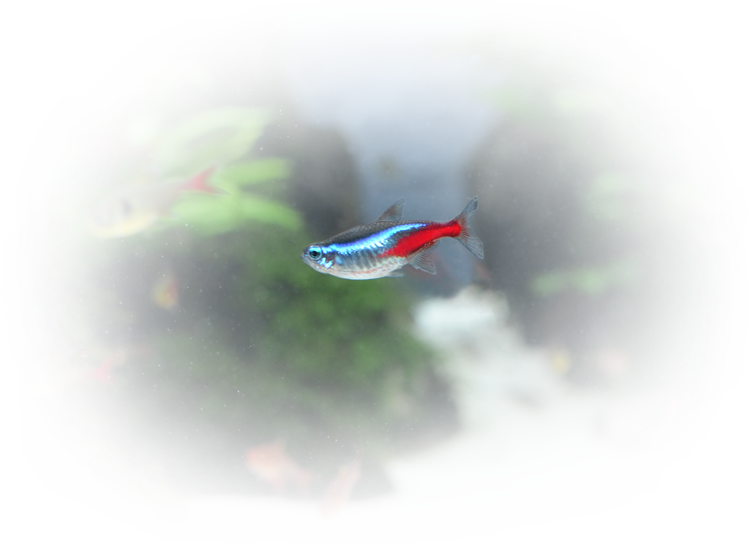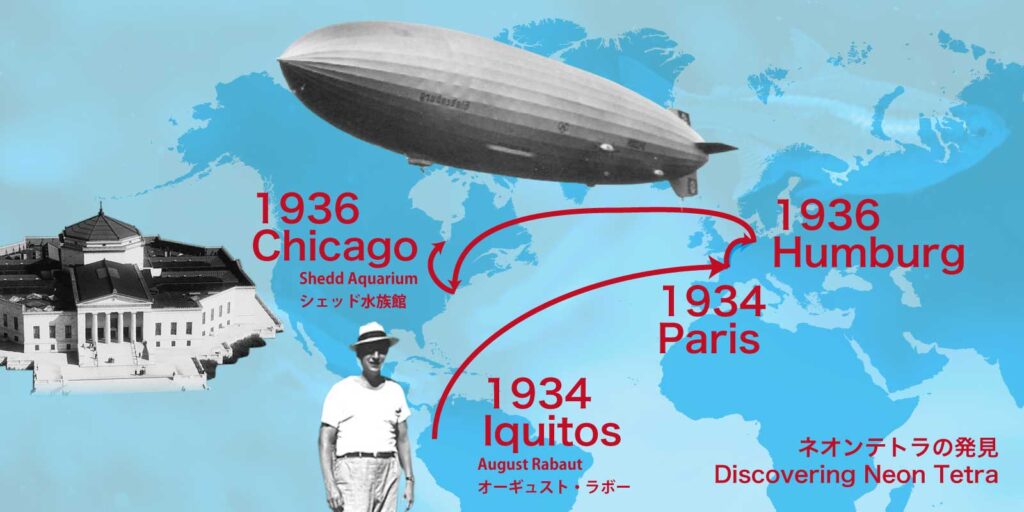
Paracheirodon innesi (Myers, 1936)
飛行船で旅したネオンテトラ
Neon Tetra Traveled by Airship
主にアマゾン川に分布します。成魚は体長約3cm、メタリックブルーの体色と腹部から尾びれ付根にかけての赤いラインが特徴的です。東南アジアで繁殖された個体が日本でも多く流通しています。
廉価で、温和な性格で飼育しやすく、他の魚と共存しやすいことから、淡水熱帯魚の入門魚として人気が高い魚です。ネオンのようなメタリックブルーは構造色と言って、モルファチョウやカワセミの体色と同じで多層膜の干渉により、青色に輝いて見えます。ネオンテトラは多層膜を構成する反射板の間隔が環境によって変わるために,ストライプの色は昼間は青,夜間は紫,餌を食べるときなど興奮状態では黄緑と色が変化します。
ネオンテトラが発見されたのは1934年のことでした。蝶を探し求めてペルーの熱帯雨林を探索していたフランス人探検家オーギュスト・ラボーが偶然見つけたのです。ラボーは13匹をフランスのレバント社に送り、レバント社はハンブルクの二人のアクアリストに売却しネオンフィッシュと名付けられました。1936年、13匹のうち5匹はシカゴのシェッド水族館に売却され、輸送されることになったのですが、運送に使われたのがかの有名なツェッペリン飛行船「ヒンデンブルク」号です。しかし、飛行船での生物の輸送は禁じられていたのでネオンフィッシュの生簀を「缶詰の魚」とすることで問題を解決したと言われています。
残念ながら5匹のうち航海を生き延びたのは 1匹だけでしたが、光り輝く一匹の魚はアメリカの人々を魅了するのに十分で、1936年にアメリカの魚類学者スプレーグ・マイヤーズによって初めて科学的に記載されたのでした。当時は高級観賞魚でしたが、1952年にドイツ人の学者が偶然に繁殖に成功して、1953年には牧野信司博士(日本熱帯魚研究所所長)が人工孵化を成功させました。そこから半世紀がたち、今では誰もが知っている観賞魚の一つとして親しまれています。
It is mainly found in the Amazon River. Adult fish are about 3 cm long and have a distinctive metallic blue body color and a red line from the abdomen to the base of the tail fin. Many individuals bred in Southeast Asia are distributed in Japan.
It is a popular introductory fish for freshwater tropical fish because it is inexpensive, has a gentle personality, is easy to raise, and can easily coexist with other fish. The neon-like metallic blue is called a structural color, and it appears to shine blue due to the interference of multilayer films, just like the body color of morpha butterflies and kingfishers. The spacing of the reflectors that make up the multilayer film of neon tetras changes depending on the environment, so the color of the stripes changes from blue during the day to purple at night, and yellow-green when excited, such as when eating.
Neon tetras were discovered in 1934. They were discovered by chance by French explorer Auguste Laveau, who was exploring the Peruvian rainforest in search of butterflies. Laveau sent 13 of them to the Levant Company in France, who sold them to two aquarists in Hamburg, who named them Neonfish. In 1936, five of the 13 were sold to the Shedd Aquarium in Chicago, and they were transported on the famous Zeppelin airship “Hindenburg”. However, it was forbidden to transport living creatures on airships, so it is said that the problem was solved by making the Neonfish’s tank “canned fish”.
Unfortunately, only one of the five survived the voyage, but the shining fish was enough to fascinate the American people, and it was scientifically described for the first time in 1936 by American ichthyologist George Sprague Myers. At the time, it was a high-end ornamental fish, but in 1952 a German scholar accidentally succeeded in breeding it, and in 1953 Dr. Shinji Makino (director of the Japanese Tropical Fish Research Institute) succeeded in artificially hatching it. Half a century has passed since then, and now it has become one of the most well-known ornamental fish.

参考文献
Shirlie Sharpe. (2023, September 21). Neon Tetra: Fish Species Profile. The Spruce Pets. 2024年7月15日閲覧
東京理科大学 創域理工学部 先端物理学科 吉岡研究室『ネオンテトラの色変化する構造色』(2010) 2024年7月15日閲覧
Noided betta (2018, 0ctober 24) “History of the Neon Tetra in Fishkeeping” Fishkeepers Amino. 2025年6月1日閲覧
Schäfer, Frank (2023, September 15) “Der Neonsalmler – ein Fisch, der die Welt veränderte” Aqualog. 2025年6月1日閲覧
note | 219回 熱帯魚馬鹿一代 | 高柳 カヨ子 (2022年12月29日) 2025年6月1日閲覧